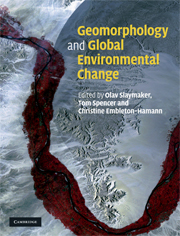Book contents
- Frontmatter
- Contents
- List of contributors
- Preface
- Acknowledgements
- List of acronyms and abbreviations
- 1 Landscape and landscape-scale processes as the unfilled niche in the global environmental change debate: an introduction
- 2 Mountains
- 3 Lakes and lake catchments
- 4 Rivers
- 5 Estuaries, coastal marshes, tidal flats and coastal dunes
- 6 Beaches, cliffs and deltas
- 7 Coral reefs
- 8 Tropical rainforests
- 9 Tropical savannas
- 10 Deserts
- 11 Mediterranean landscapes
- 12 Temperate forests and rangelands
- 13 Tundra and permafrost-dominated taiga
- 14 Ice sheets and ice caps
- 15 Landscape, landscape-scale processes and global environmental change: synthesis and new agendas for the twenty-first century
- Index
2 - Mountains
Published online by Cambridge University Press: 05 July 2015
- Frontmatter
- Contents
- List of contributors
- Preface
- Acknowledgements
- List of acronyms and abbreviations
- 1 Landscape and landscape-scale processes as the unfilled niche in the global environmental change debate: an introduction
- 2 Mountains
- 3 Lakes and lake catchments
- 4 Rivers
- 5 Estuaries, coastal marshes, tidal flats and coastal dunes
- 6 Beaches, cliffs and deltas
- 7 Coral reefs
- 8 Tropical rainforests
- 9 Tropical savannas
- 10 Deserts
- 11 Mediterranean landscapes
- 12 Temperate forests and rangelands
- 13 Tundra and permafrost-dominated taiga
- 14 Ice sheets and ice caps
- 15 Landscape, landscape-scale processes and global environmental change: synthesis and new agendas for the twenty-first century
- Index
Summary
Introduction
There is greater geodiversity in mountains than in most other landscapes (Barsch and Caine, 1984). Mountain geo-systems are not exceptionally fragile but they show a greater range of vulnerability to disturbance than many landscapes. Forested slopes give place to alpine tundra over short vertical distances; resistant bedrock slopes alternate with intensively cultivated soils and erodible unconsolidated sediments over short horizontal distances. Mountain systems account for roughly 20% of the terrestrial surface area of the globe.
Mountains are high and steep so that when natural hazards occur, whether seismic, volcanic, mass movements or floods, the disturbance is transmitted readily through the geosystem. When inappropriate land use changes are made, vegetation and soils are rapidly removed. Because of the steep terrain, low temperatures and the relatively thin soils, the recovery of mountain geosystems from disturbance is often slow and sometimes fails completely. Mountains provide the direct life support base for 10 – 20% of human- kind (statistics differ on this point; see Appendix 2.1) and indirectly affect the lives of more than 50%. Because of significant elevation differences, mountains such as the Himalayas, the Andes, the Rocky Mountains and the Alps show, within short horizontal and vertical distances, climatic regimes similar to those of widely separate latitudinal belts. Because of the compressed life zones with elevation and small-scale biodiversity caused by different topoclimates, mountain systems are of prime conservation value. Körner and Ohsawa (2005) estimate that 32% of protected areas are in mountains (9345 protected areas covering about 1.7 Mkm2).
Human well-being also depends on mountain geodiversity and biodiversity. Mountain systems are especially important for the provision of clean water and the safety of settlements and transport routes depends directly on ability to cope with natural hazards. Slope stability and erosion control are also closely interdependent with a healthy and continuous vegetation cover.
- Type
- Chapter
- Information
- Geomorphology and Global Environmental Change , pp. 37 - 70Publisher: Cambridge University PressPrint publication year: 2009
- 12
- Cited by



